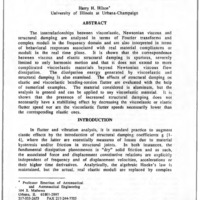Viscoelastic And Structural Damping Analysis
Item
-
Title
-
Viscoelastic And Structural Damping Analysis
-
Report Number
-
WL-TR-91-3078 Volume III, p. ICB-1 thru ICB-15
-
Creator
-
Hilton, Harry H.
-
Corporate Author
-
University of Illinois at Urbana-Champaign
-
Date
-
1991
-
Date Issued
-
1991-08
-
Extent
-
15
-
Identifier
-
ADA241313
-
Format
-
1 online resource
-
Abstract
-
The interrelationships between viscoelastic, Newtonian viscous and
structural damping are analyzed in terms of Fourier transforms and
complex moduli in the frequency domain and are also interpreted in terms
of behavioral responses associated with real material compliances or
moduli in the real time plane. It is shown that the correspondence
between viscous and elastic structural damping is spurious, severely
limited to only harmonic motion and that it does not extend to more
complicated viscoelastic materials beyond Newtonian viscous flow
dissipation. The dissipation energy generated by viscoelastic and
structural damping is also examined. The effects of structural damping on
elastic and viscoelastic bending-torsion flutter are evaluated with the help
of numerical examples. The material considered is aluminum, but the
analysis is general and can be applied to any viscoelastic material. It is
shown that the presence of increased structural damping does not
necessarily have a stabilizing effect by decreasing the viscoelastic or elastic
flutter speed nor are the viscoelastic flutter speeds necessarily lower than
the corresponding elastic ones.
-
Description
-
The interrelationships between viscoelastic, Newtonian viscous and
structural damping are analyzed in terms of Fourier transforms and
complex moduli in the frequency domain and are also interpreted in terms
of behavioral responses associated with real material compliances or
moduli in the real time plane. It is shown that the correspondence
between viscous and elastic structural damping is spurious, severely
limited to only harmonic motion and that it does not extend to more
complicated viscoelastic materials beyond Newtonian viscous flow
dissipation. The dissipation energy generated by viscoelastic and
structural damping is also examined. The effects of structural damping on
elastic and viscoelastic bending-torsion flutter are evaluated with the help
of numerical examples. The material considered is aluminum, but the
analysis is general and can be applied to any viscoelastic material. It is
shown that the presence of increased structural damping does not
necessarily have a stabilizing effect by decreasing the viscoelastic or elastic
flutter speed nor are the viscoelastic flutter speeds necessarily lower than
the corresponding elastic ones.
-
Distribution Classification
-
1
-
Distribution Conflict
-
No
-
DTIC Record Exists
-
No
-
Illinois Tech Related
-
No
-
Photo Quality
-
Not Needed
-
Report Availability
-
Full text available
-
Type
-
article
